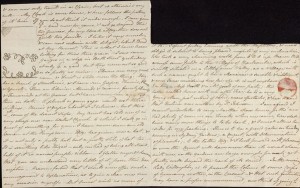Part II: Letters, real (but not ordinary)
Last week’s blog concerned what a ‘proper letter’ is deemed to be. It suggested that fictional and literary variants (an example from Jane Austen’s novel Persuasion was commented on) are sometimes taken as though definitional of ‘the letter’, although the large majority of ‘real letters’ (ie. not fictional ones) are business-like in sense of expediting dialogical and material exchanges between people. They are humdrum and purposive, rather than studied, but which is not to disclaim that they might also be artful.
This blog continues the debate, by focusing on ‘real’ letters by the same person who wrote the ‘proper’ but fictional letter discussed previously. These are Jane Austen’s letters, written to her close family, mainly but not exclusively to her much loved sister Cassandra whenever they were apart. Most often they are long and detailed and filled with what in the extracted letter below, of 9 December 1808, she calls ‘little matters’ – although with tongue in epistolary cheek about this. In this letter, for instance, such matters include a letter from Cassandra to her and which was accompanied by that of a Mr Deedes, Miss Curling being in Portsmouth, the delivery of some bracelets, a visit by two friends, her sending up the match-making designs of a family connection (Mrs Knight), events at a recent dance, a letter arriving for Cassandra, and the ‘weightier’ matter (last in the line, with a sense of leading up to this), that their brother James, a curate, was to receive an extra £100 a year (worth now about an extra £12,000 or more) from relatives.

Jane Austen (1775-1817), Autograph letter signed, with a drawing of the lace pattern of her cloak: Bath, to Cassandra Austen, 2 June 1799, Purchased by J. P. Morgan, Jr., 1920; MA 977.4, Photography by Schecter Lee, 2009.
Austen’s letters are also – as the business-like exchanges of ordinary letters typically are – immensely elliptical. Cassandra’s knowledge of who people are, what prior events had happened, and that slight shifts of tone and turns of phrase in the letter could signify sarcasm, humour, distain and so on is of the essence in fully understanding Austen’s letters. As a consequence, those who now read what were written as private communications between two people do so as through a glass, darkly, because lacking such knowledge. These letters are recipient-designed and -oriented ones, then, and their dialogical aspects are clear in other ways too, above all in Austen informing her sister of little matters as of large and doing so in terms that Cassandra would appreciate. One instance of the many possible shows the dialogical character well. The sharpness of the humour about Mrs Knight in Austen’s 9 December 1808 letter is notable; the comment Austen writes is funny but not cuddly (as reading the whole paragraph in the letter will show); and it owes much to a ironically disposed sense of humour shared by Cassandra and Jane.
Certainly Austen’s 9 December 1808 letter is in its way an artful one, with its way including both structure (the ‘little matters’ leading to the communication of ‘some weight’) and content (the things written about being carefully tailored to Cassandra’s interests and tastes). However, while this is writerly in its command over the medium of expression, it also resulted from pressing practical concerns, not just those of art. As another letter a few weeks after, also to Cassandra, puts it, in writing her expected letter to her sister there was a practical matter that Austen had to grapple with. This was that “we are doing nothing ourselves to write about, and I am therefore quite dependent upon the communications of our friends, or my own wits.” (10 Jan 1809). Both these other letters and ‘her own wits’ come into play and are traceable in the unfolding of the letter, deployed to give herself something to write about.
Next week’s blog will conclude this three-part discussion by considering head-on the question of whether real and fictional letters can be told apart and if so how.
Extracts from Austen’s 9 December 1808 letter now follow, with … indicating omissions. However, to get the most from it, best read the whole letter (The Letters of Jane Austen, ed Deidre Le Faye, 2014, Oxford University Press).
9 December 1808
Castle Square
Friday
Many thanks, my dear Cassandra, to you and Mr. Deedes for your joint and agreeable composition…
…I am extremely foolish in writing all this unnecessary stuff when I have so many matters to write about that my paper will hardly hold it all. Little matters they are, to be sure, but highly important.
In the first place, Miss Curling is actually at Portsmouth, which I was always in hopes would not happen…
The bracelets are in my possession, and everything I could wish them to be… Soon after I had closed my last letter to you we were visited by Mrs. Dickens and her sister-in-law, Mrs. Bertie…
I am very much obliged to Mrs. Knight for such a proof of the interest she takes in me, and she may depend upon it that I will marry Mr. Papillon, whatever may be his reluctance or my own…
Our ball was rather more amusing than I expected…
You will not expect to hear that I was asked to dance, but I was—by the gentleman whom we met that Sunday…
Yesterday I—or rather, you—had a letter from Nanny Hilliard…
Having now cleared away my smaller articles of news, I come to a communication of some weight; no less than that my uncle and aunt are going to allow James 100l. a year. We hear of it through Steventon…
I have but one thing more to tell you. Mrs. Hill called on my mother yesterday while we were gone to Chiswell…
Yours ever sincerely, J. A.
Last updated: 21 January 2016





